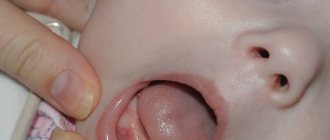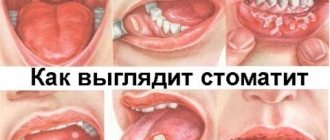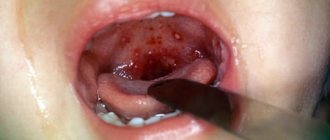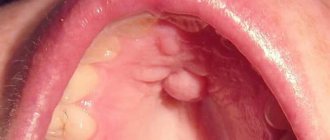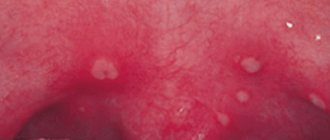September 30, 2020 Last revised: December 17, 2020 Oral diseases
There are cases when children turn to adults with the problem of a sore throat, when parents begin to study their child’s throat, they notice something like pimples on the palate - red dots in the mouth. In medicine, these inflammations are defined as enanthema. Are these inflammations so dangerous and in what cases do you need the help of a doctor?
Signs of malfunctions in the mucosa in the form of enanthema
Enanthema can be of various types due to the specifics of the disease. The main provocateurs of enanthema are various viruses and bacteria. General signs of inflammation of the mucous membrane in a child will be as follows:
- the baby begins to have a sore throat and itching;
- it becomes difficult to swallow;
- the child has difficulty breathing;
- Pain appears throughout the body and it seems to begin to break;
- a dry cough does not allow the child to live peacefully, especially after waking up and before bedtime;
- rarely does enanthema go away without elevated body temperature.
Malignant melanoma
Melanoma (type of cancer)
Malignant melanoma is a type of skin cancer that can cause dark spots not only on the skin, but also on the gums and other mucous membranes of the mouth. Although malignant melanoma is the most common form of cancer, it rarely affects the mouth.
This disease most often occurs in people who smoke. It may appear as one dark spot that slowly grows over time to form a tumor. Urgent and proper medical examination and treatment is required. You need to observe changes in the color, shape and size of the spot.
We suggest you read: Eye pain due to inflammation of the trigeminal nerve
Why does my child have red dots on his throat?
A child may experience redness in the throat due to various diseases, but all these diseases can be combined into three groups:
- viruses
- bacteria
- allergy
Each individual disease and group of diseases have certain signs by which you can navigate, which is why protrusions appeared on the mucous membrane. But an accurate diagnosis can only be made by a specialist with proper diagnosis.
Viruses
A viral infection is often accompanied by spots on the throat. Most often, these spots are red and small, they appear on the upper palate, back wall and uvula.
In addition to spots on the throat, viruses have several other symptoms:
- high body temperature;
- the child feels weak;
- a runny nose appears, and the child also begins to sneeze frequently;
- a dry cough appears.
In cases of a viral infection, separate treatment for red spots on the throat is not required. It is enough to treat the disease with standard methods: gargling, taking cough suppressants, staying at rest, and regularly drinking fluids.
With influenza, the enanthema will have a bright red appearance, with granular rashes. These spots in the throat appear approximately on the second day of illness, along with other symptoms of the disease: chills, body pain, weakness.
Influenza is treated in the same way as viral infections, but with the caveat that this disease is more complex and develops faster, so powerful drugs (Tamiflu, etc.) are used in treatment.
Other viral infections that can cause enanthema are stomatitis and herpes sore throat. With such diseases, red spots will appear on the throat, resembling not pimples, but blisters. Looking at such redness, the doctor is able to accurately diagnose. For such diseases, standard treatment against a viral infection is prescribed.
Bacteria
It is easier for bacteria, unlike viral cells, to gain a foothold in the body, because bacteria are already formed organisms. In order for them to exist and develop, it is enough to get into a comfortable living environment, and the mucous membrane of the throat is just that.
Most often, bacteria enter the body with weakened immunity. Bacterial infections are more unpleasant than viral ones because... they are accompanied by a large number of unpleasant symptoms. In cases where a bacterial infection is not cleared from the body in time, it begins to spread throughout the body, entering the blood and all internal organs of a person. A bacterial infection can affect: kidneys, heart, blood cells and skin.
Therefore, it is important to consult a doctor immediately, because... Throat bumps caused by bacteria can lead to serious complications later on.
Allergy
The easiest way to get rid of enanthema caused by an allergic reaction is to simply eliminate the allergen. A sign that the inflammation was due to an allergy is simple - the pimples will not just be red, but with white spots inside them.
In order to determine exactly what caused the allergic reaction, it is recommended to consult a doctor to conduct a blood test to detect allergies. This procedure is inexpensive, but will help quickly eliminate the allergens that caused the child’s reaction.
Other causes of enanthema
It is not always possible to quickly identify the cause of spots on the throat. Most often, difficulties arise with making a diagnosis in infants. This is due to the fact that babies taste everything that comes to hand, and these things are not always clean.
Due to contact with dirty objects, a child may develop a fungus, which sometimes manifests itself in the form of spots or pimples on the throat. Frequent fungal diseases are: thrush (this disease has white spots and looks like cottage cheese) and fungal tonsillitis.
Each of these diseases has approximately the same symptoms, because they are caused by the same pathogen. If treatment is not started in time, the fungus spreads throughout the throat, covering it with a white coating.
When treating a fungus, it is necessary to use agents that can stop the growth of the fungus.
In cases where a child behaves as if he is healthy, but red pimples appear on his throat, it is necessary to immediately take him to the doctor, because there is a high probability that the baby has swallowed substances that can burn the mucous membrane. If you do not get help from specialists in time, the consequences can be disastrous.
What infectious diseases are accompanied by a rash in the mouth?
Most often, red spots in the mouth appear due to infection. But the rash will not be the only symptom. The body temperature will rise, the throat will begin to hurt, the person will feel general weakness and pain when swallowing. Associated symptoms determine the type of infection.
These may be influenza, herpes simplex virus, chickenpox, rubella, measles, mononucleosis, erythema infectiosum, roseola, scarlet fever, typhus, syphilis, staphylococcal infection, meningitis. The list of diseases is quite wide, and all of them are very dangerous.
We suggest that you familiarize yourself with Toothpaste for removing tartar
A child's body copes with a viral infection more easily. In case of chickenpox, scarlet fever or rubella, a long quarantine is required, but the child’s condition does not cause concern. After recovery, persistent lifelong immunity is acquired. But measles, rubella and chickenpox are dangerous for adults, they are severe and cause various complications. Treatment is often carried out in a hospital.
In young children, the following diseases, manifested by a rash, are severe:
- Primary infection with the herpes virus.
- Herpetic sore throat.
- Stomatitis.
Important: These diseases develop rapidly and acutely.
Prevention
In order to minimize the possibility of spots on the throat, it is necessary to properly care for your child:
- The baby's immune system must be strong. The child should often be in the fresh air and eat only healthy foods. You can also add vitamin complexes to your diet.
- We must not forget about hygiene, including oral hygiene.
- Caries should be treated as soon as it appears.
- You need to get vaccinated on time.
- At a time when outbreaks of infections occur, it is better to refrain from appearing in public places with your child.
Black spots on gums from smoking
Excessive smoking and use of other tobacco products is another possible cause of these dark spots on the gums. Smoking is thought to cause malignant melanoma, the deadliest form of skin cancer, but it is rarely found in the mouth. According to the United States National Library of Medicine, oral melanoma accounts for about 8% of all melanomas.
Your risk of developing mouth cancer increases if you smoke, chew tobacco, or drink hard liquor. Oral melanoma often begins as a small, irregularly shaped black spot with jagged edges that grows slowly.
For long-time smokers, oral melanoma is often fatal. It may go undetected until it reaches an advanced stage. Without treatment, the average lifespan is 2 years. To prevent this from happening, you need to quit smoking and reduce your consumption of tobacco products. Regular oral examinations can also help detect melanoma at an early stage.
Enanthema in adults
Adults are characterized by the same signs and diseases when spots appear on the throat as in children. In addition to infections, adults often have problems with the appearance of enanthema due to: side effects of medications, poisoning with heavy metals, iodine, etc.
Enanthema can be primary or secondary.
- Primary. Various appearances on the intact surface of the throat. The primary category includes several types:
- Stains. This is a flat type of enanthema.
- Nodules and bumps. These performances do not contain a cavity.
- Ulcers and blisters. They often open up and are also capable of forming secondary defects.
- Secondary. This category of enanthema occurs in the form of erosions, cracks, ulcers, etc. These appearances appear due to transformations of the primary elements.
How is enanthema treated in an adult?
Treatment is prescribed depending on the reasons that caused the enanthema. First of all, they get rid of the disease itself, the consequence of which was enanthema.
During treatment, it is recommended to avoid physical activity. The diet should contain only soft foods; in addition, spicy, sour and hot foods should be excluded.
You can resort to traditional medicine only on the recommendation of a doctor; a specialist may recommend gargling with a herbal decoction.
Chicken pox
Often, red spots that appear in the mouth of a small child signal the development of chickenpox. The disease occurs against the background of primary infection of the body with the Varicella Zoster virus.
Over time, the eruptive elements that appear on the palate transform into bubbles, burst and take on the appearance of itchy ulcers. Ulcerative formations on the mucous membrane heal completely in 3-4 days.
Clinical signs that help differentiate chickenpox from other diseases accompanied by the appearance of a rash in the upper part of the oropharynx include:
- blistering rashes localized on the skin of the extremities, head, torso and face;
- skin itching;
- headache;
- low-grade fever;
- somnological disorders (insomnia, restless sleep);
- loss of appetite;
- constant feeling of fatigue.
We suggest you familiarize yourself with Temperature after tooth extraction with flux.
Specific treatment for chickenpox has not yet been developed. The disease is treated at home using symptomatic remedies. Spots that appear on the mucous membrane of the palate are treated daily with antiseptic solutions. In addition, the patient is recommended to remain in bed, take vitamins, antipruritics and antipyretics (if indicated).
How to relieve symptoms
Doctors cannot always immediately make a diagnosis, explaining the cause of inflammation in the throat mucosa. In addition to infectious diseases, spots on the throat can be the result of chronic or oncological diseases. At the first rash on the mucous membrane, you should consult a doctor to get tests done and begin treatment faster.
Various herbal rinses (chamomile, sage, oak bark, yarrow, etc.) will help relieve discomfort, and the pimples themselves can be treated with solutions such as Miramistin or its analogues. Swelling caused by enanthema can be relieved with antihistamines.
Blood blisters: main causes
The condition of the body can be judged by the integrity of the mucous membrane. Often, it is enough for a doctor to visually examine the oral mucosa and its formations to establish an unambiguous diagnosis. Almost any infectious disease is reflected in the relief and shade of the mucous membrane. It would not be amiss to have at least a general understanding of the factors that provoke such rashes in the mouth.
The three main locations of such blisters are: the inside of the cheek, the space under the tongue, the space on the tongue. They signal serious abnormalities in the functioning of the body, sometimes as a result of mechanical injury. Most often, a rash of blisters indicates abnormalities associated with the gastrointestinal tract, metabolic problems, and stomatitis.
Sometimes such points appear on the tongue
Important! A blood bubble is a direct continuation of a violation of the integrity of the mucous membrane.
There are three main categories of shell damage:
- mechanical damage. This can be triggered by foreign objects, food with sharp edges, or accidental biting;
- chemical damage. Provocateurs: food high in spices and salt, direct contact with chemical products. Chemicals easily corrode the sensitive membrane;
- damage due to temperature. Excessively hot foods can trigger this.
The blood bubble itself is not very dangerous. As already mentioned, it is a natural reaction of the body to an external stimulus. An open wound is attacked by elements of the external environment, and the body launches a defense mechanism.
This mechanism involves many actions.
The immune system is the first to go into battle. It directs a large number of elements to combat the irritant and, as a rule, they reduce the effect of the latter to a minimum.
The immune system actively fights infections that could enter the body through such a point
In case of damage to the above-mentioned elements, hormone-transmitters take over. They provoke a spasm of the humoral system, blocking the outflow of blood. This process continues as long as the body deems necessary. After its completion, blood balance is restored. The pressure of the blood flow increases, which provokes the formation of a specific blister.
